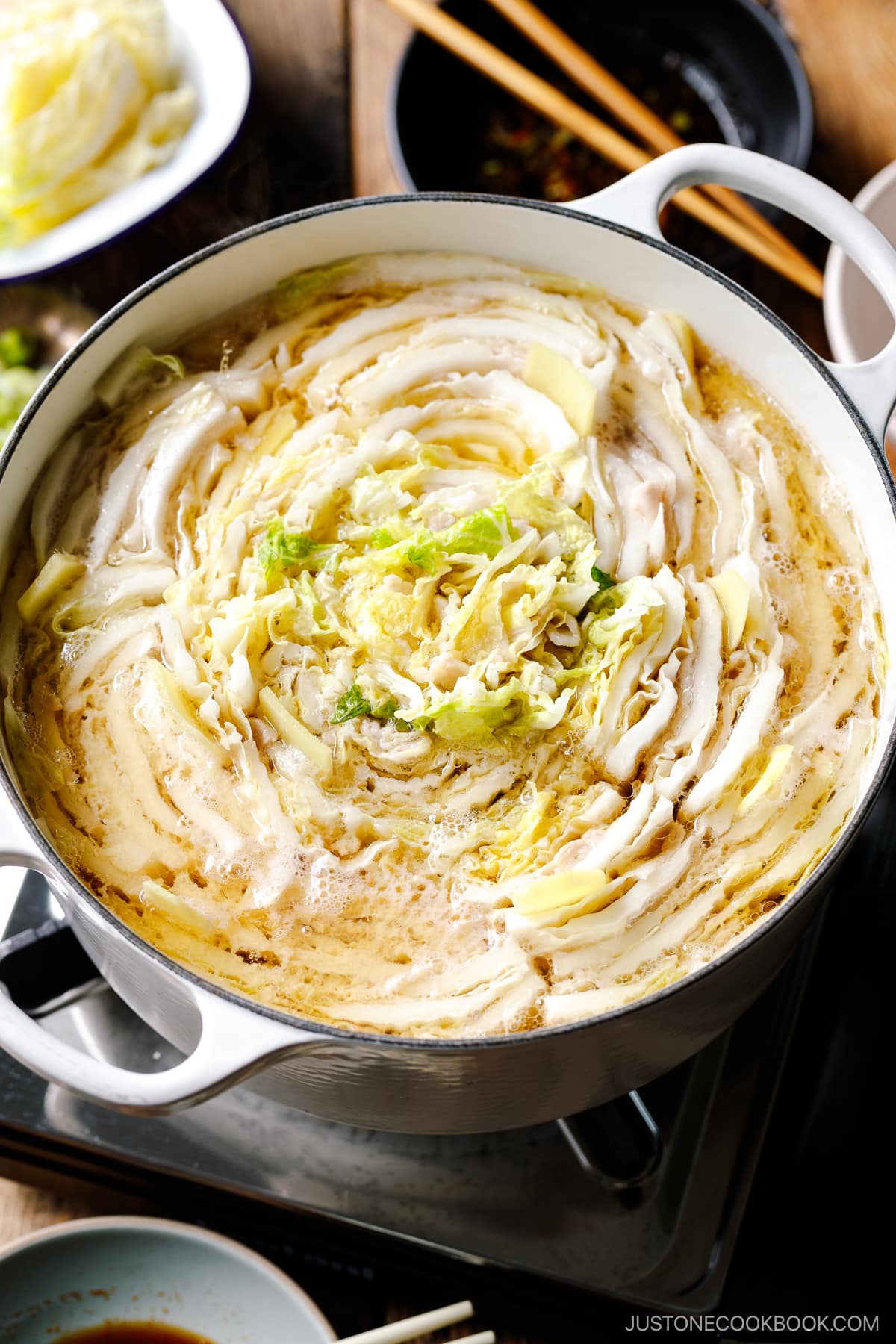
Mille-Feuille Nabe is a simple Japanese hot pot made with layers of napa cabbage and pork belly slices cooked in a savory dashi broth. Prized for its visual appeal and balance of umami flavor, this dish creates an amazing harmonious taste from just a few ingredients.
If you’re craving more hot pot recipes, try my Shabu Shabu, Sukiyaki, and Yosenabe next!
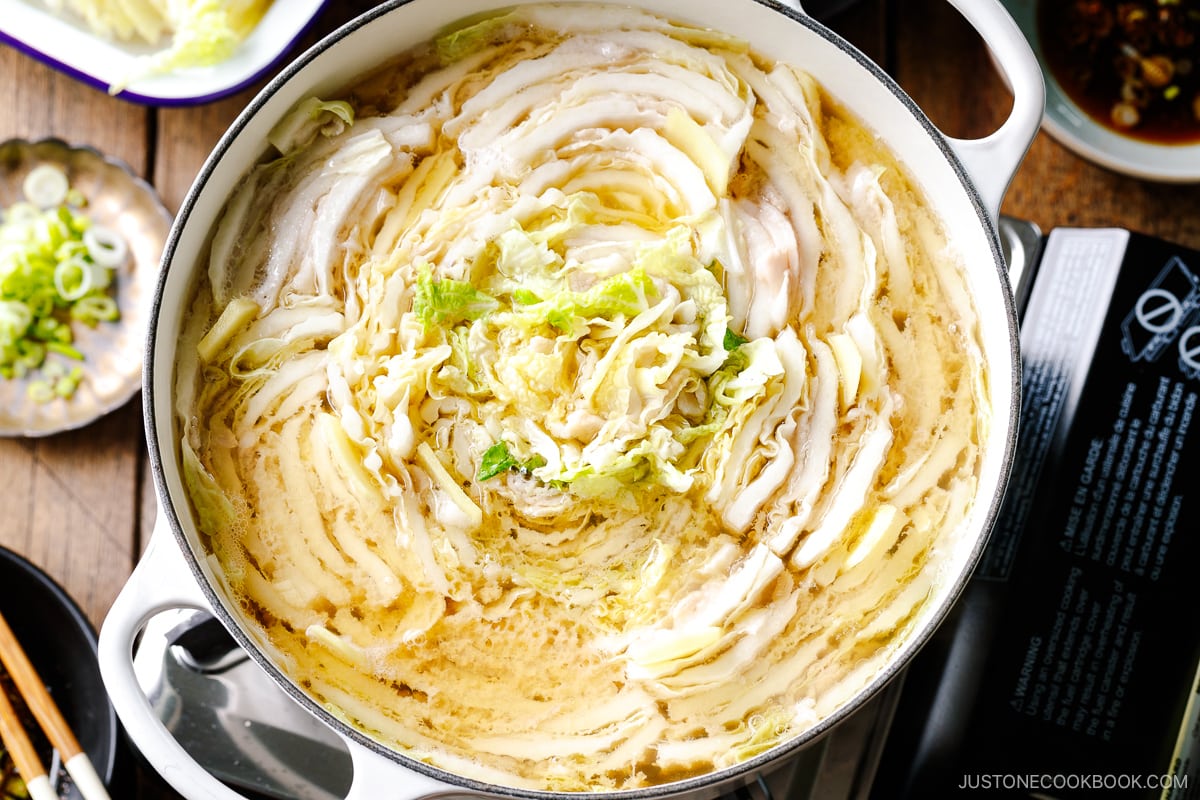
What is Mille-Feuille Nabe?
Mille-feuille nabe (ミルフィーユ鍋, 重ね鍋) is a Japanese hot pot dish named after the French term mille-feuille or “a thousand leaves.” The term refers to a French dessert of puff pastry layered with cream and powdered sugar. Mille-feuille nabe is likewise layered, but instead with tender cabbage leaves and pork belly slices in a favorite style of hot pot in Japanese homes.
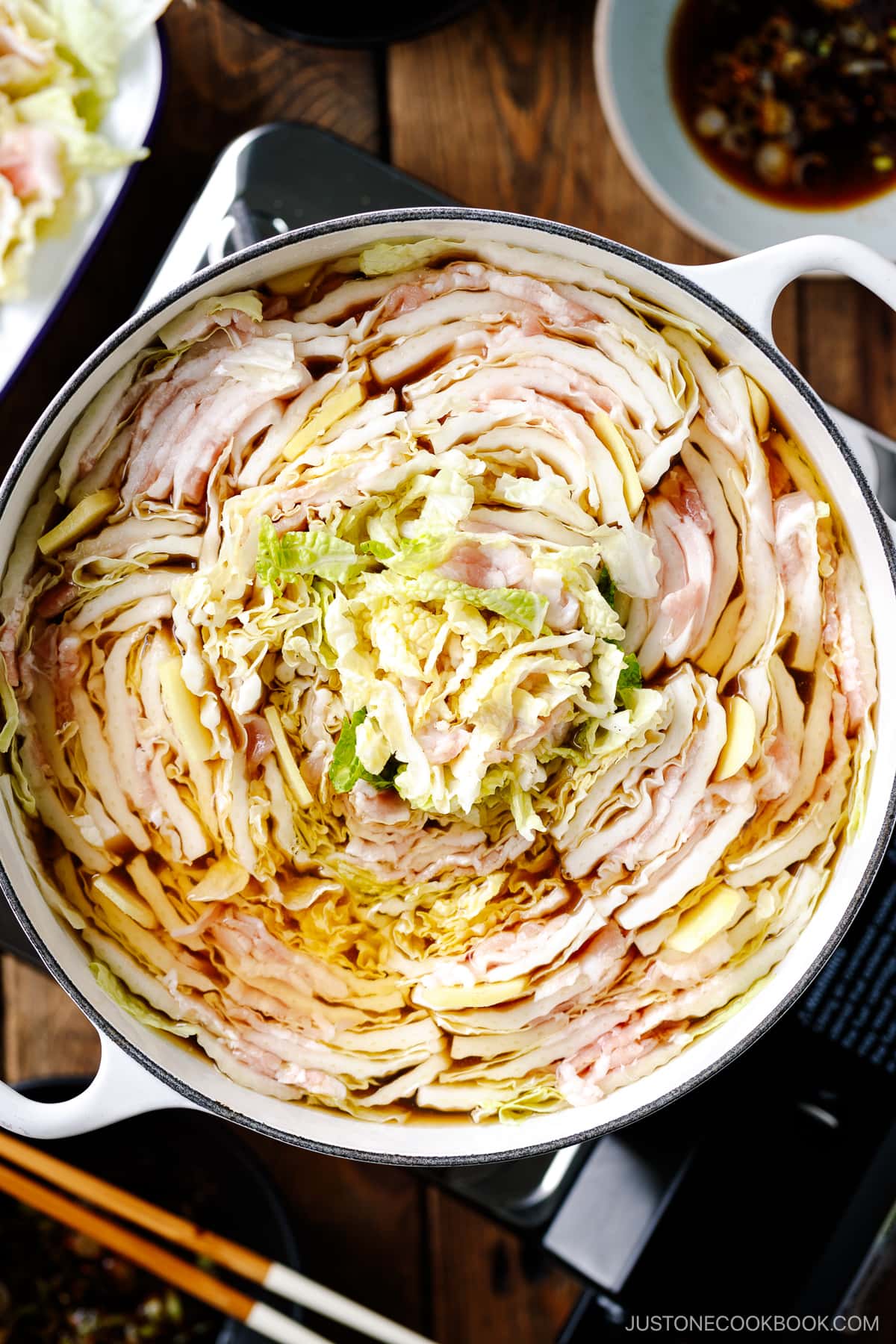
Ingredients for Mille-Feuille Nabe
- Napa cabbage
- Pork belly slices
- Ginger
- Dashi (Japanese soup stock)
- Seasonings – soy sauce, sake, and salt
- Dipping sauce:
- Ponzu sauce
- Green onion
- Shichimi togarashi (Japanese seven spice) – optional, for a spicy kick
Find the printable recipe with measurements below.
Jump to RecipeSubstitutions
- Napa cabbage: I love the natural sweetness of napa cabbage (compared to green cabbage), and the leaves are thinner and more tender. If you can’t find it, substitute baby bok choy or sliced daikon.
- Pork belly: JOC readers who don’t eat pork have tried this recipe with thinly sliced beef, and they loved it. Just a quick reminder that beef tends to release more scum as you cook, so be ready to skim off the scum and fat with a fine-mesh skimmer.
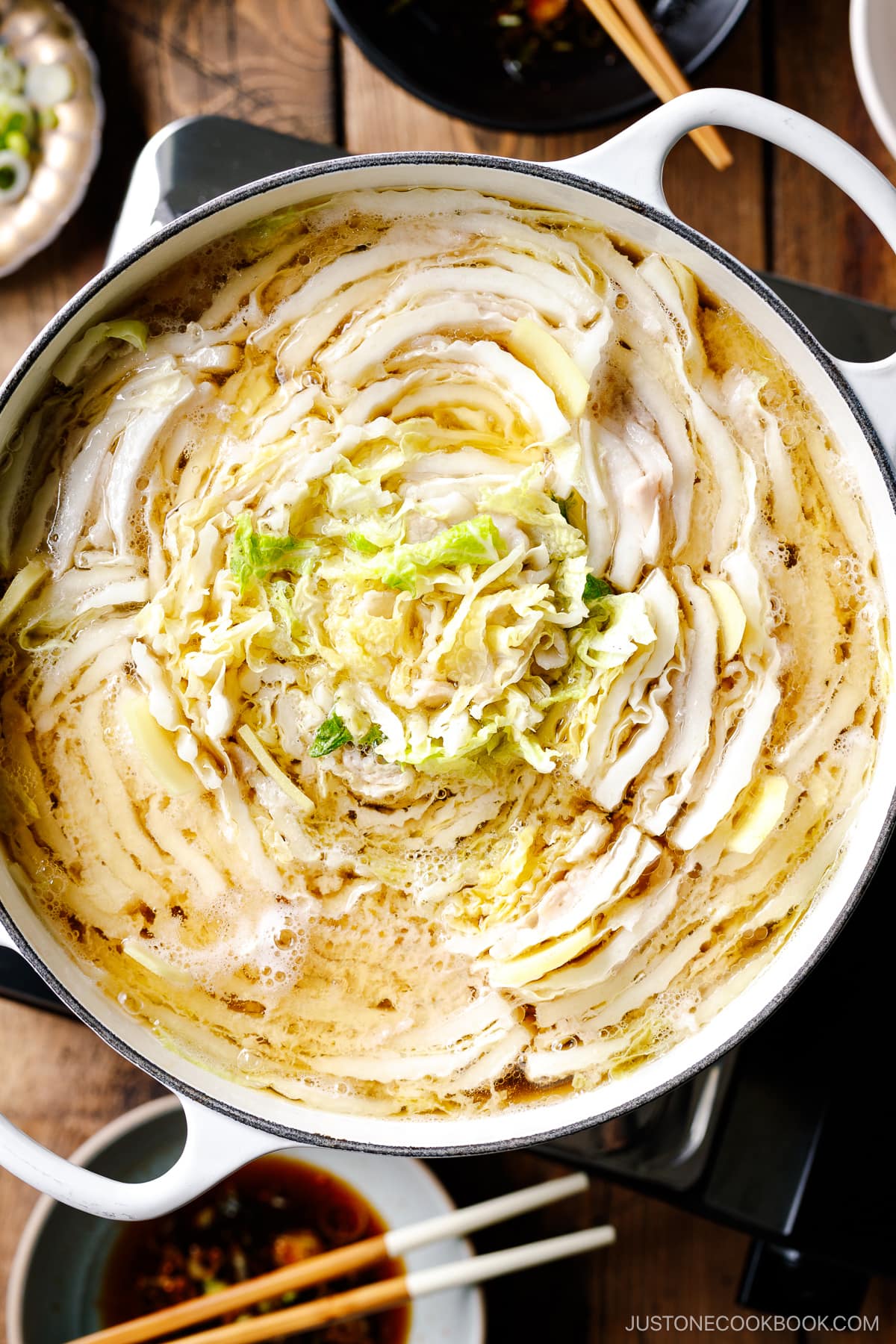
How to Make Mille-Feuille Nabe
Preparation
Step 1 – Make the broth and cut the ingredients. Prepare the soup broth. Slice the vegetables. Cut the napa cabbage into quarters and rinse them under water to remove dirt.
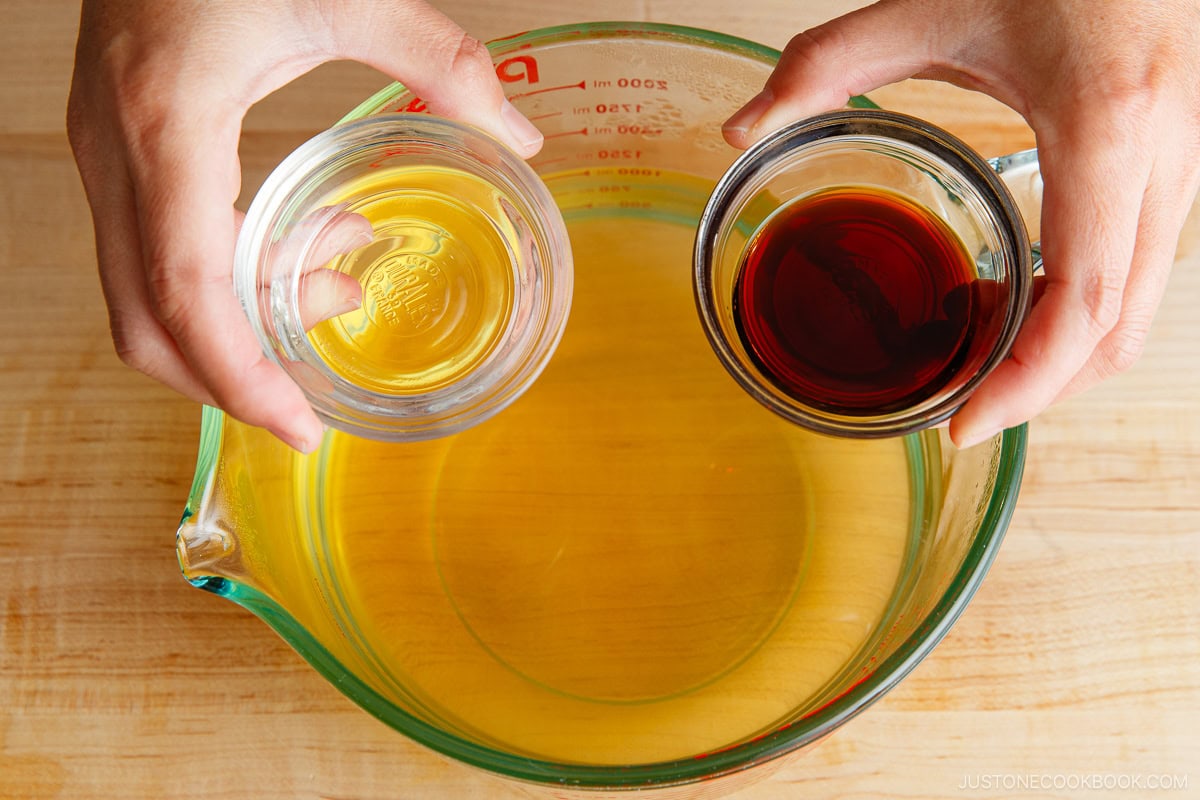
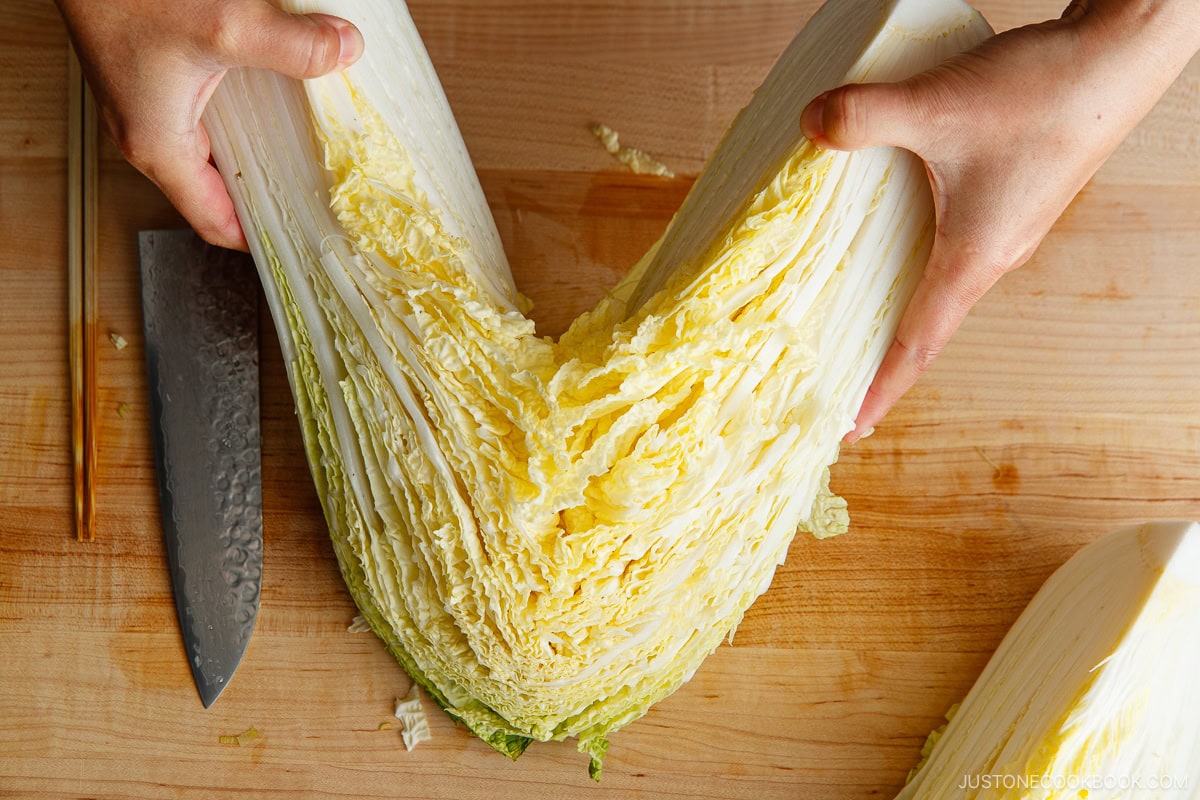
Step 2 – Layer. Layer the slices of pork belly between the cabbage slices, then carefully cut them into layered pieces about 2–2½ inches (5–6 cm) long.
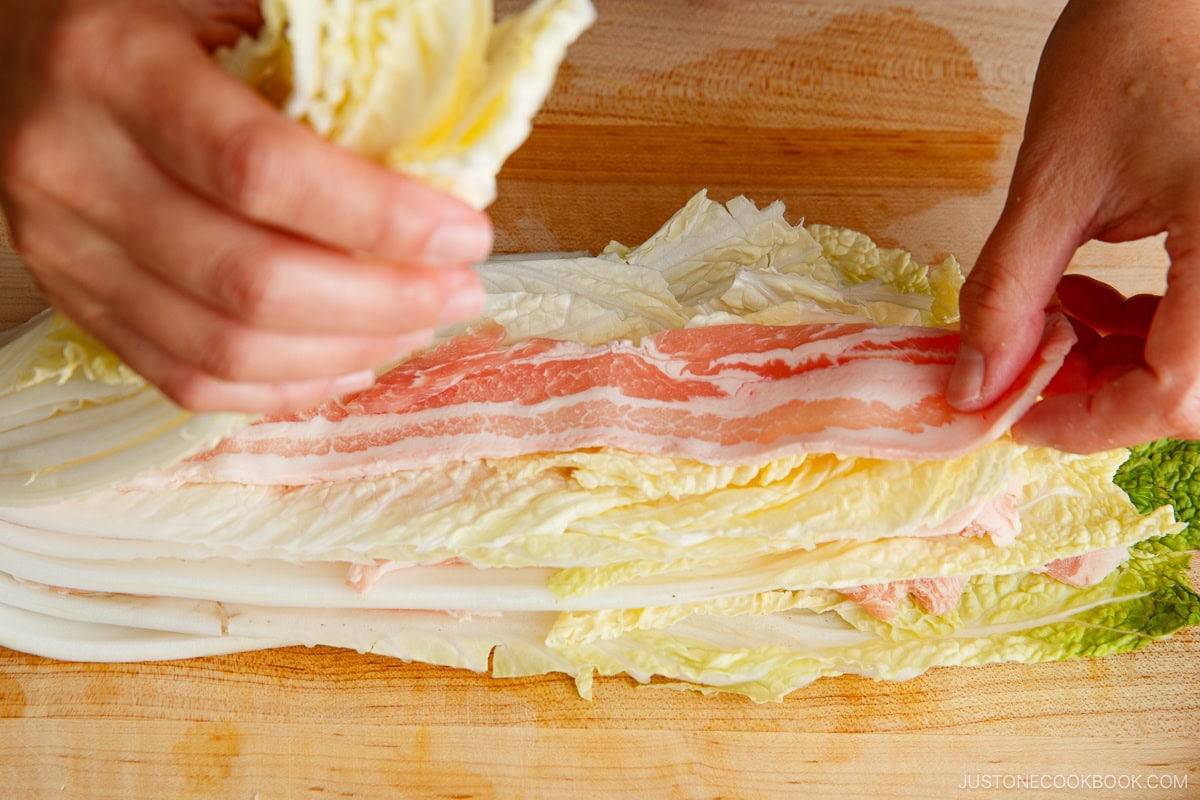
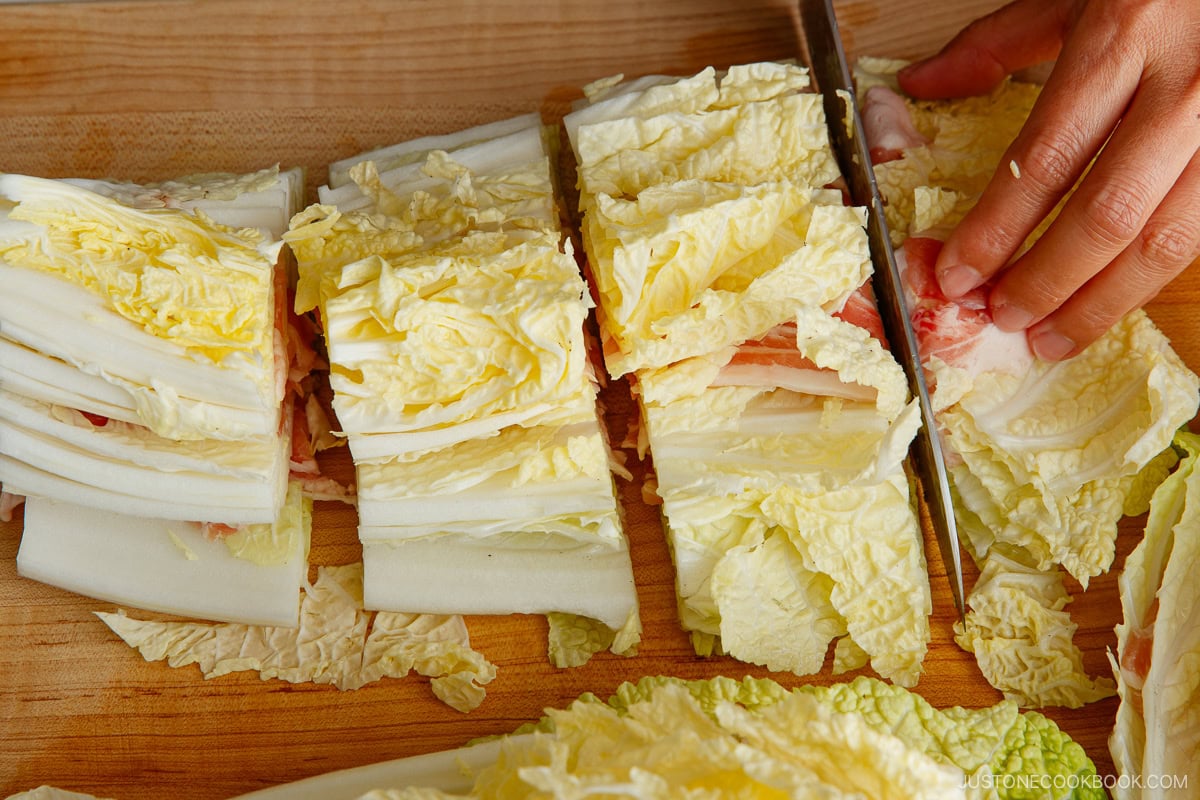
Assemble
Step 3 – Pack the pot. Tightly pack the layered cabbage and pork into a pot, working your way toward the center. Insert the ginger slices between the cabbage and pour the broth on top.
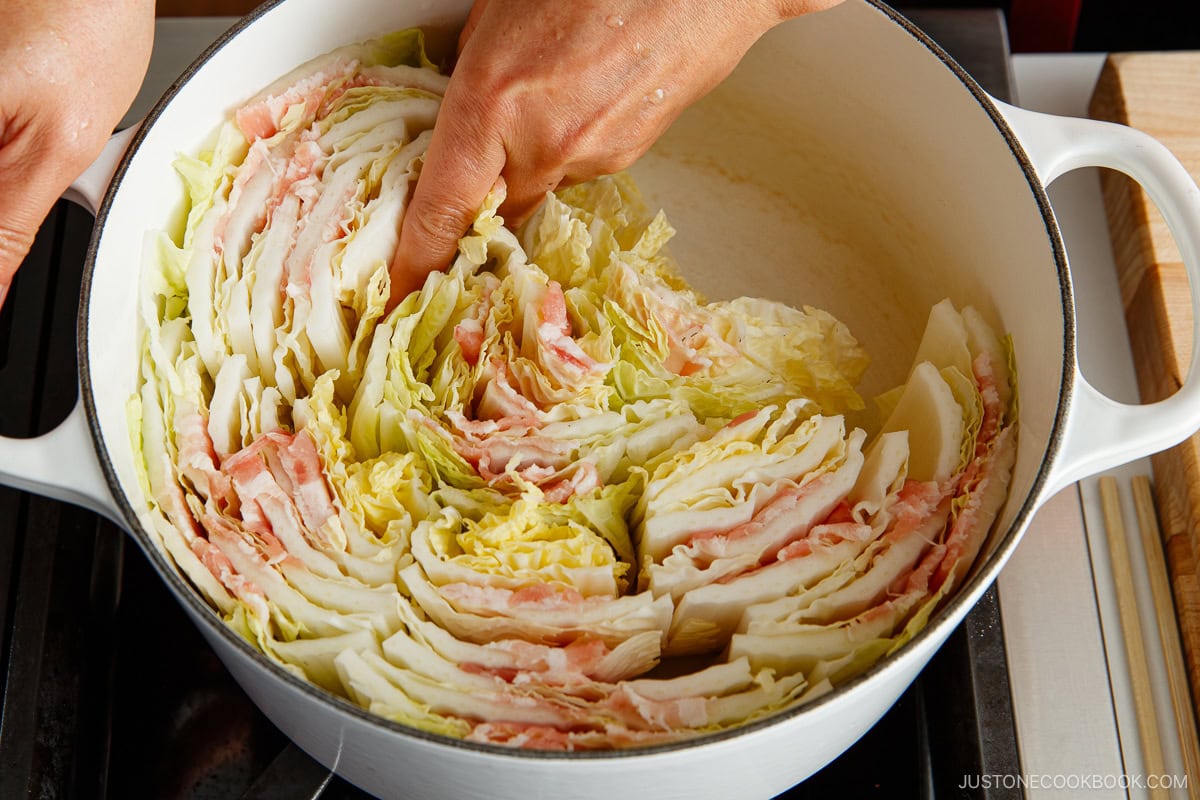
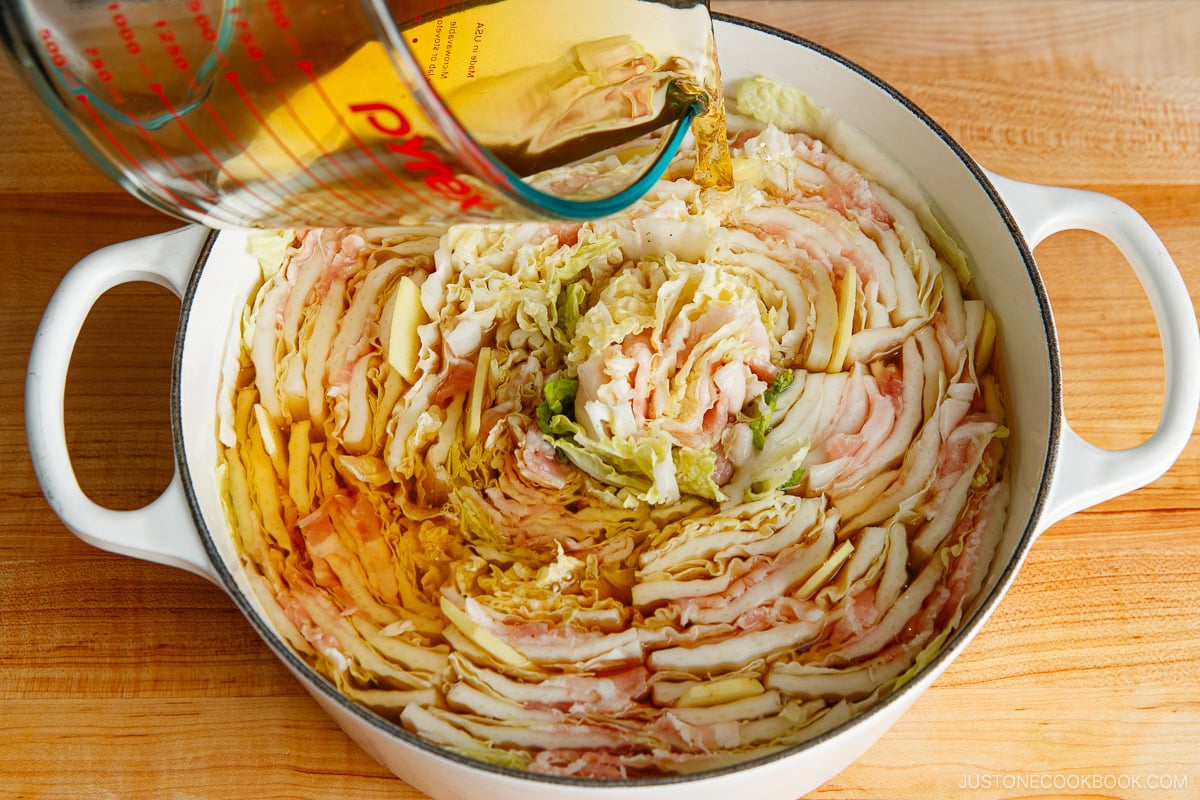
Cooking
Step 4 – Simmer. Cover the lid and bring to a boil. Then, reduce to medium-high heat and simmer until the cabbage is tender and the pork is fully cooked. Meanwhile, make the dipping sauce by combining the sauce ingredients in a mixing bowl.

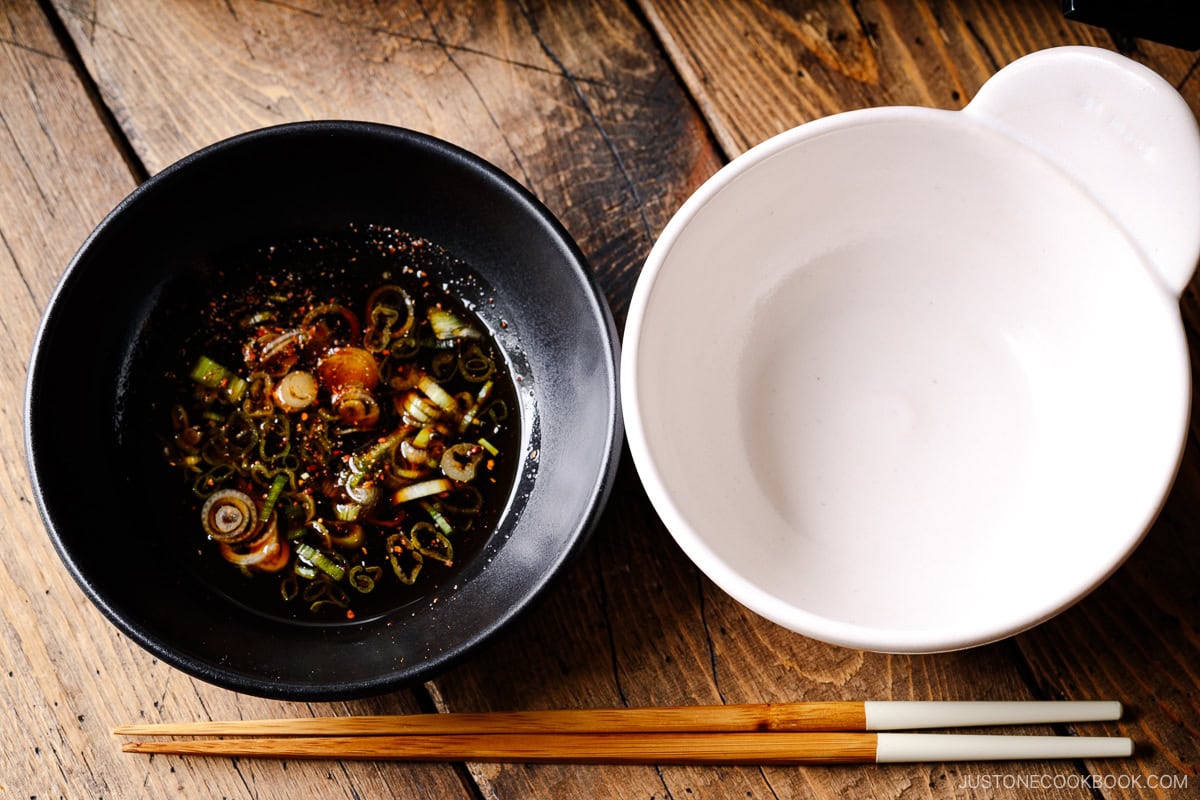
Step 5 – Serve. Serve with ponzu dipping sauce on the side.
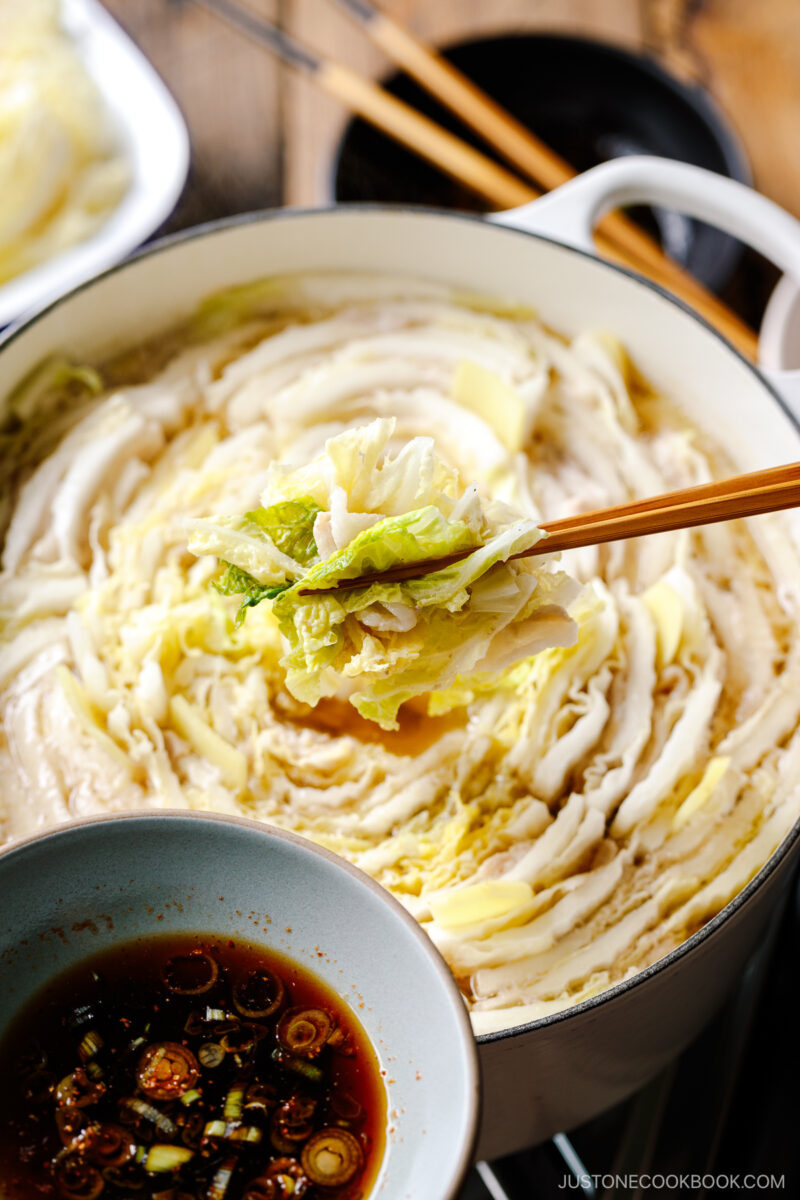
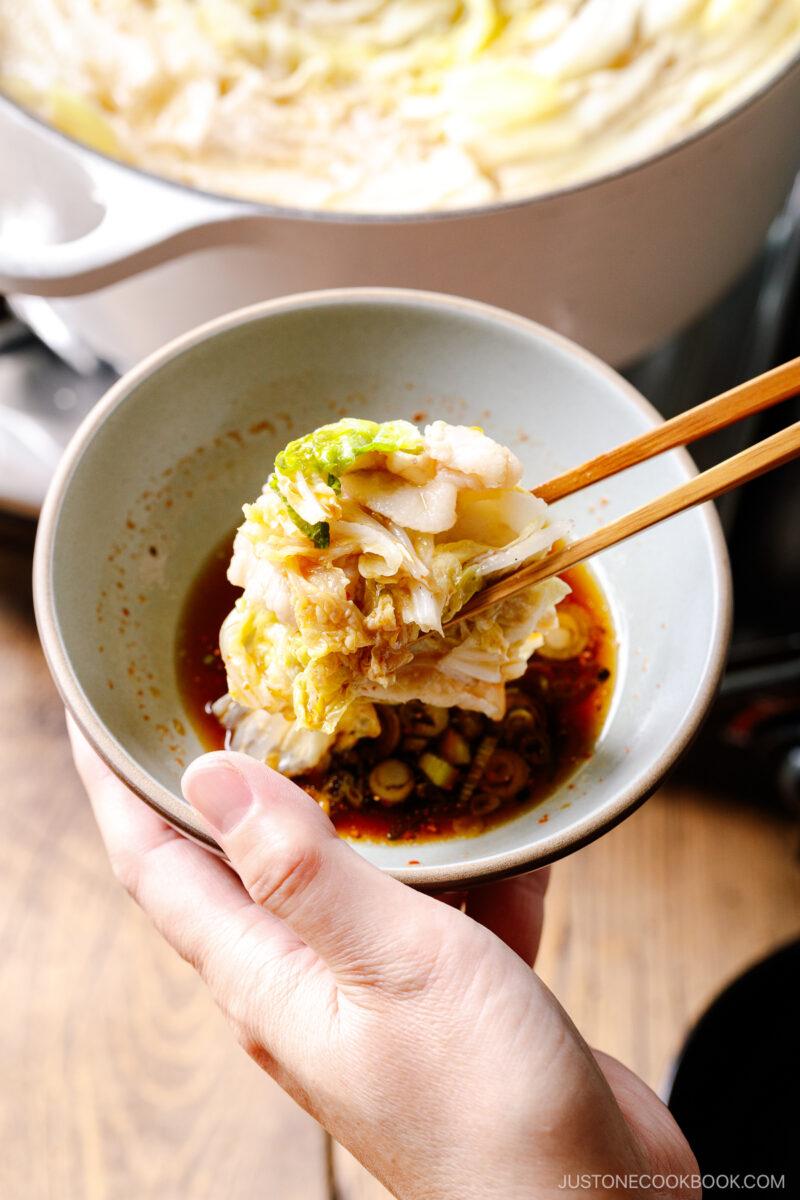
Nami’s Recipe Tips
- Running out of cabbage? It can happen, especially if this is your first time making this dish. I recommend having shimeji mushrooms or enoki mushrooms as a backup filler for any empty space in the center of the pot.
- Pack the layers tightly! The key to making this nabe is ensuring the layers are tightly packed in. Cabbage releases water and shrinks as it cooks, causing the layers to loosen.
- Start by packing from the outer edges of the pot and work your way toward the center. I usually place the thicker cabbage leaves near the pot’s edge and the tender leaves in the center.
- Use one hand to hold the layers in the pot and the other hand to add more layers. Don’t worry if the layers become a bit loose; you can adjust them by bunching them up against each other as you add more.
Variations and Customizations
- Make it vegan. Some of our readers use Vegan Dashi and mushrooms or thinly sliced vegetables instead of pork belly, and they love it!
- Add more vegetables. Napa cabbage is the traditional choice, but you can add other thinly sliced veggies.
- Make a finishing course. With the leftover umami-packed soup, make a final dish called shime (〆, しめ) to end the meal. Simply simmer one serving of udon noodles, chuka soba (ramen noodles; Mr. JOC’s favorite), or steamed rice in the broth. I like to make Zosui with the rice by drizzling in the beaten egg as it simmers, then topping it with salt, ground white pepper, and chopped green onion.
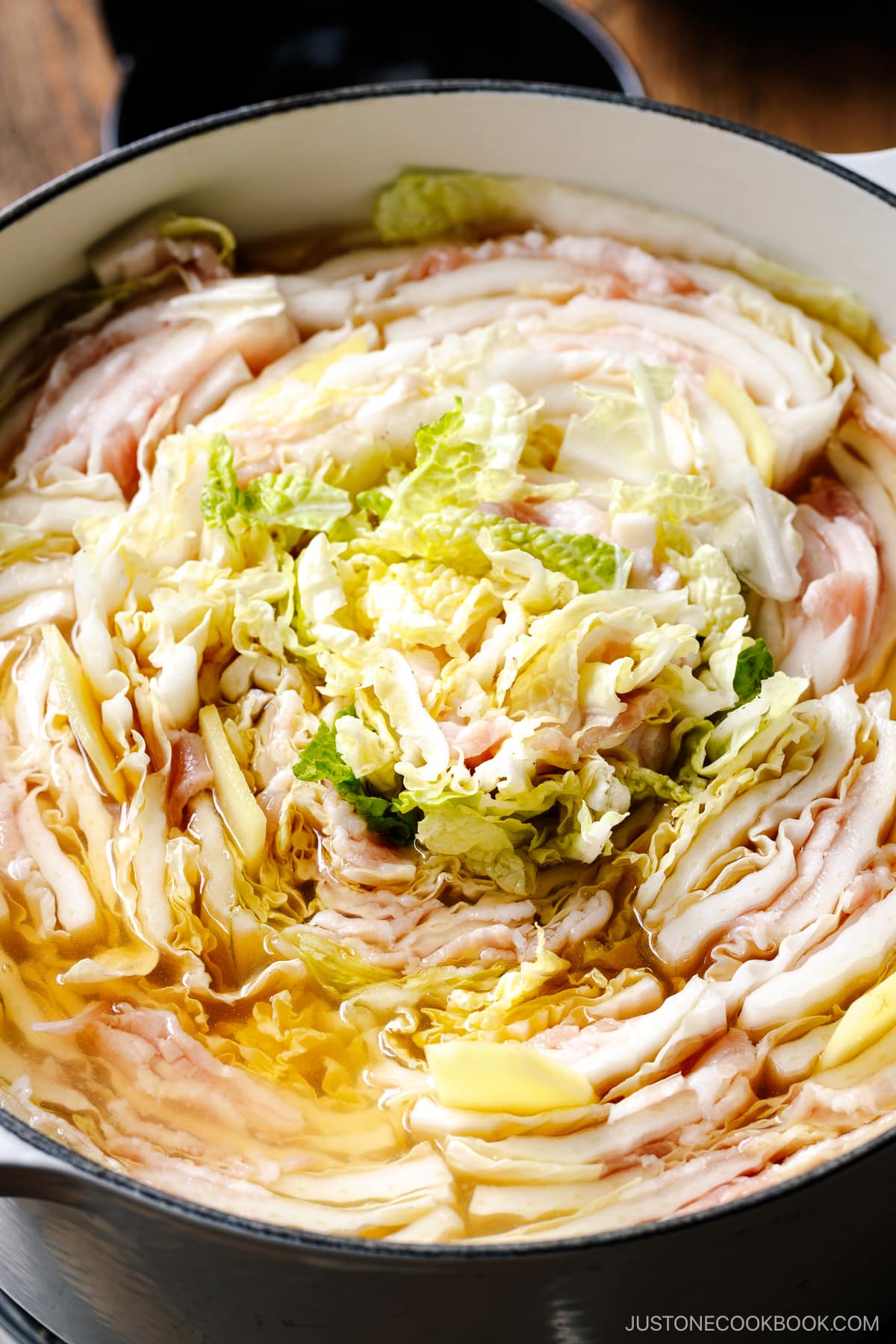
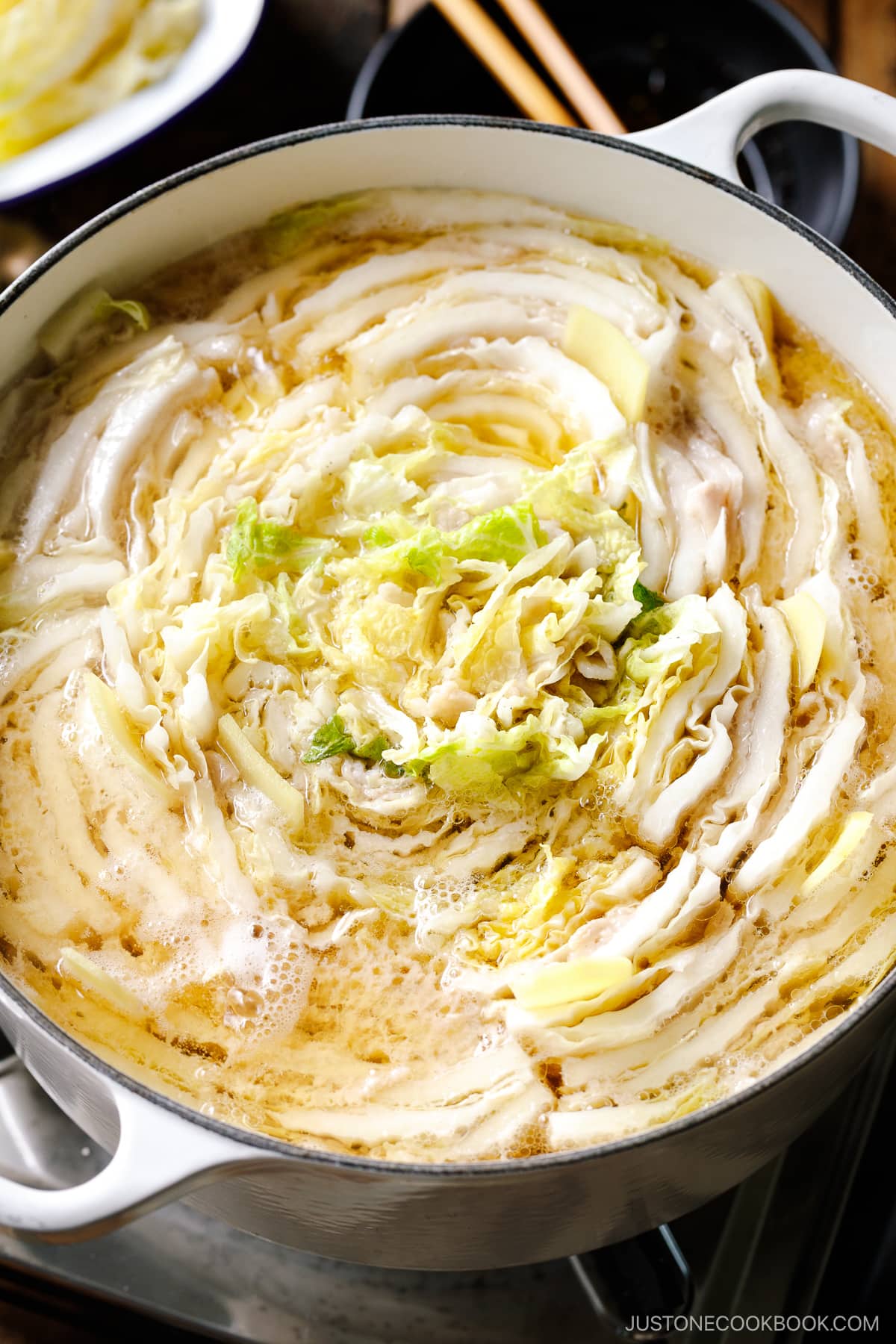
What to Serve with Mille-Feuille Nabe
- Rice – Learn How to Cook Japanese Rice in a Pot on the Stove.
- Sides – Try Kinpira Gobo, Green Bean Gomaae, and Asazuke (Japanese Lightly Pickled Vegetables). Make them ahead of time. These dishes add a wonderful flavor and texture contrast.
- Noodles – My kids like to add frozen udon noodles to the leftover broth for the finishing course.
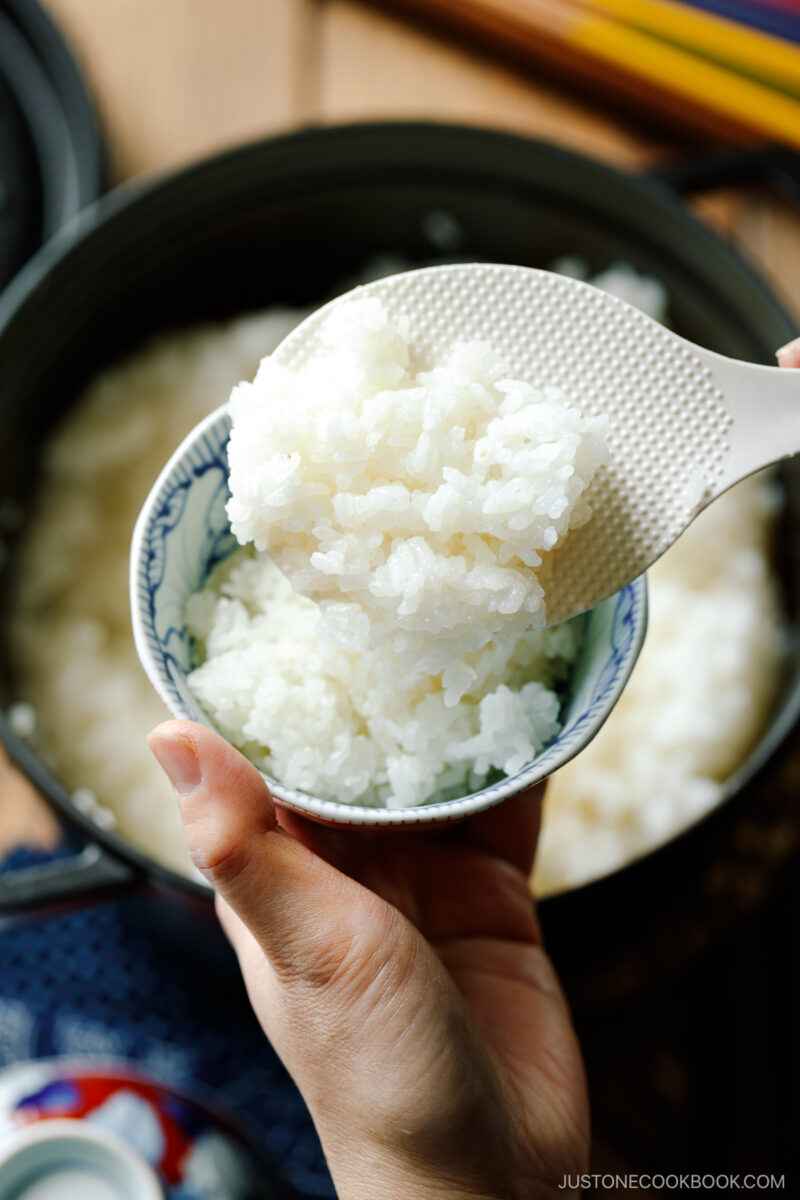
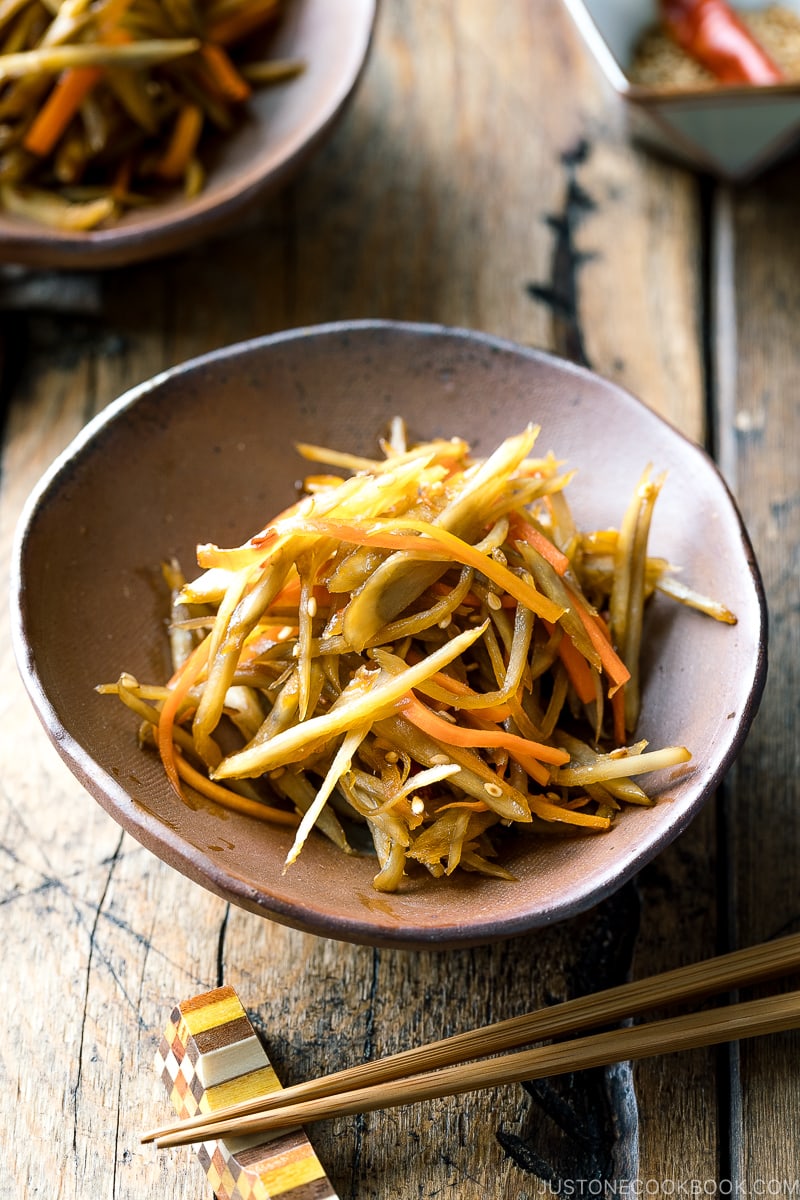
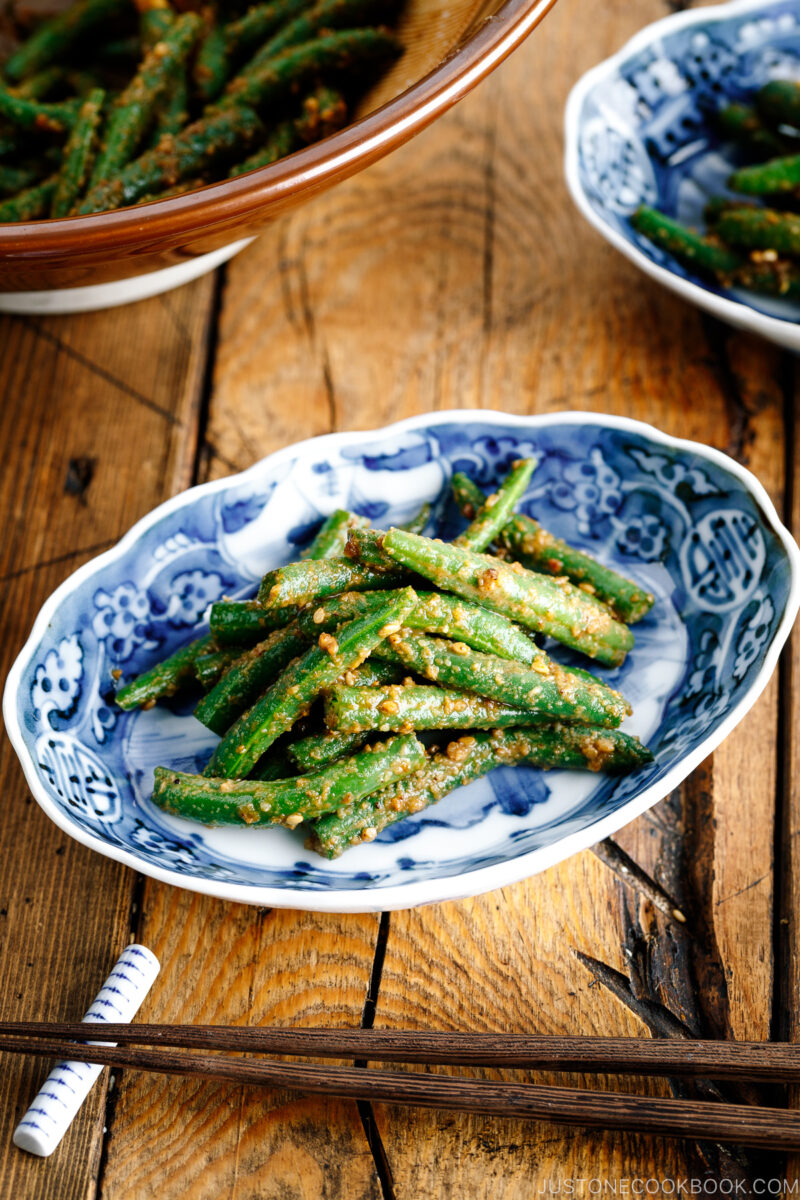
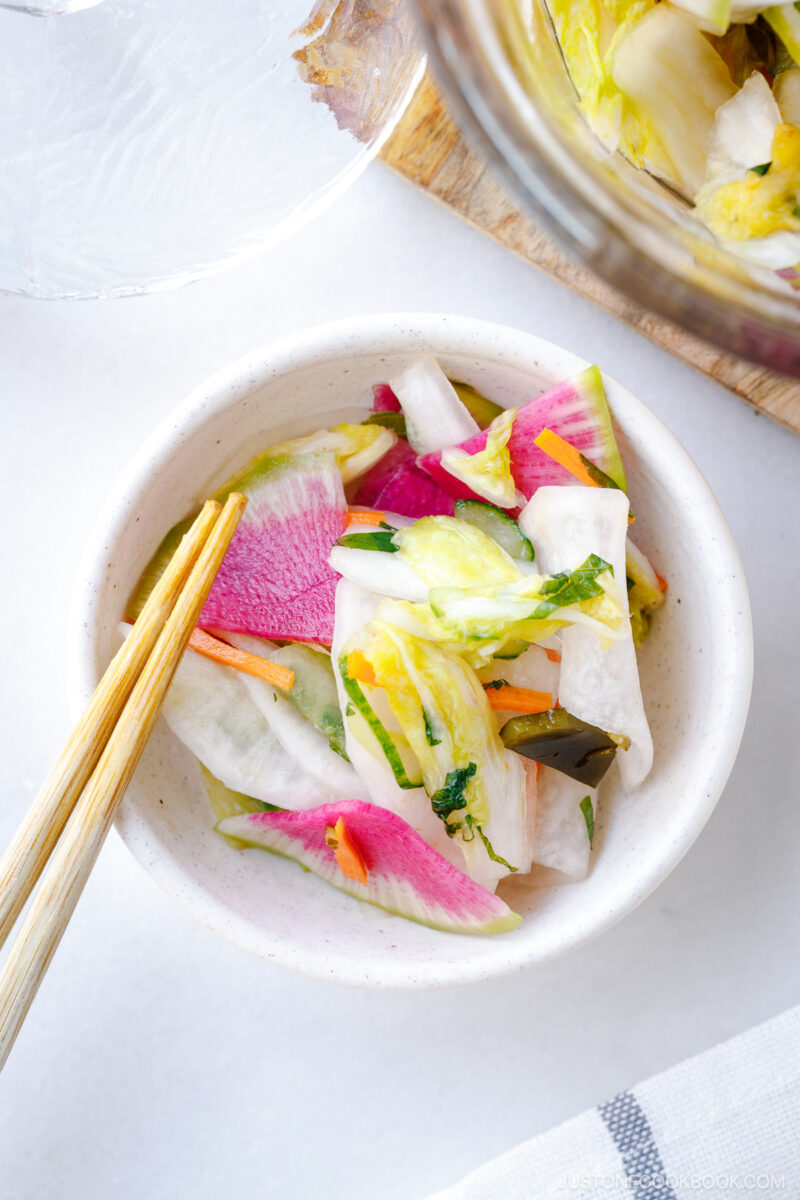
Storage and Reheating Tips
To store: Allow the nabe to cool uncovered, then store in an airtight container for up to 3 days in the fridge or up to 1 month in the freezer.
To reheat: Simmer leftovers in a saucepan over medium heat until warm, or microwave in 30-second intervals.
Frequently Asked Questions
I do not recommend using bacon in place of pork belly, as bacon is very salty and can often times be too fatty.
Yes, you can prepare and assemble everything ahead of time and store it in the refrigerator. Hold off on adding the broth and cooking the cabbage until right before you’re ready to serve.
Mille-Feuille Nabe
Ingredients
- 1 head napa cabbage (4 lbs, 1.8 kg)
- 1½ lb sliced pork belly (see Notes for where to buy it pre-sliced; or learn how to slice meat thinly at home; do not use bacon, since it‘s too salty)
For the Broth
- 8–10 slices ginger (peeled and thinly sliced from a 1-inch, 2.5-cm knob)
- 5 cups dashi (Japanese soup stock) (use standard Awase Dashi, dashi packet or powder, or Vegan Dashi)
- 2 Tbsp sake
- 1 Tbsp soy sauce
- ½ tsp Diamond Crystal kosher salt
For the Dipping Sauce
- 1 green onion/scallion
- ponzu
- shichimi togarashi (Japanese seven spice) (optional, for a spicy kick)
Instructions
- Before You Start: Make 5 cups dashi (Japanese soup stock) of your choice. Here, I'll show you a quick version using my favorite dashi packet. First, add 2 dashi packets to 5 cups water in a saucepan. Start cooking over medium heat. When it reaches a boil, reduce the heat to medium low and simmer for 2–3 minutes. Turn off the heat. Remove the packets from the saucepan, shake them a few times to release more flavor, then discard them. The dashi is now ready to use.
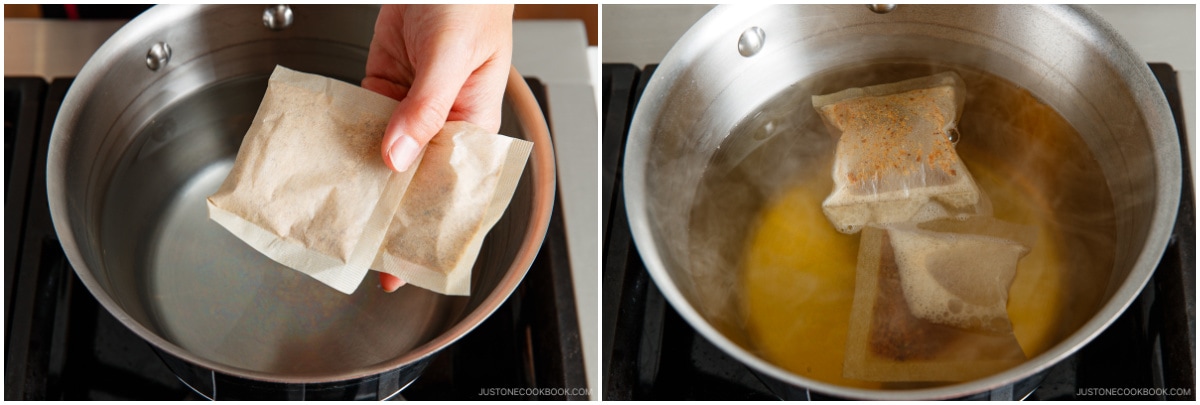
- Gather all the ingredients.
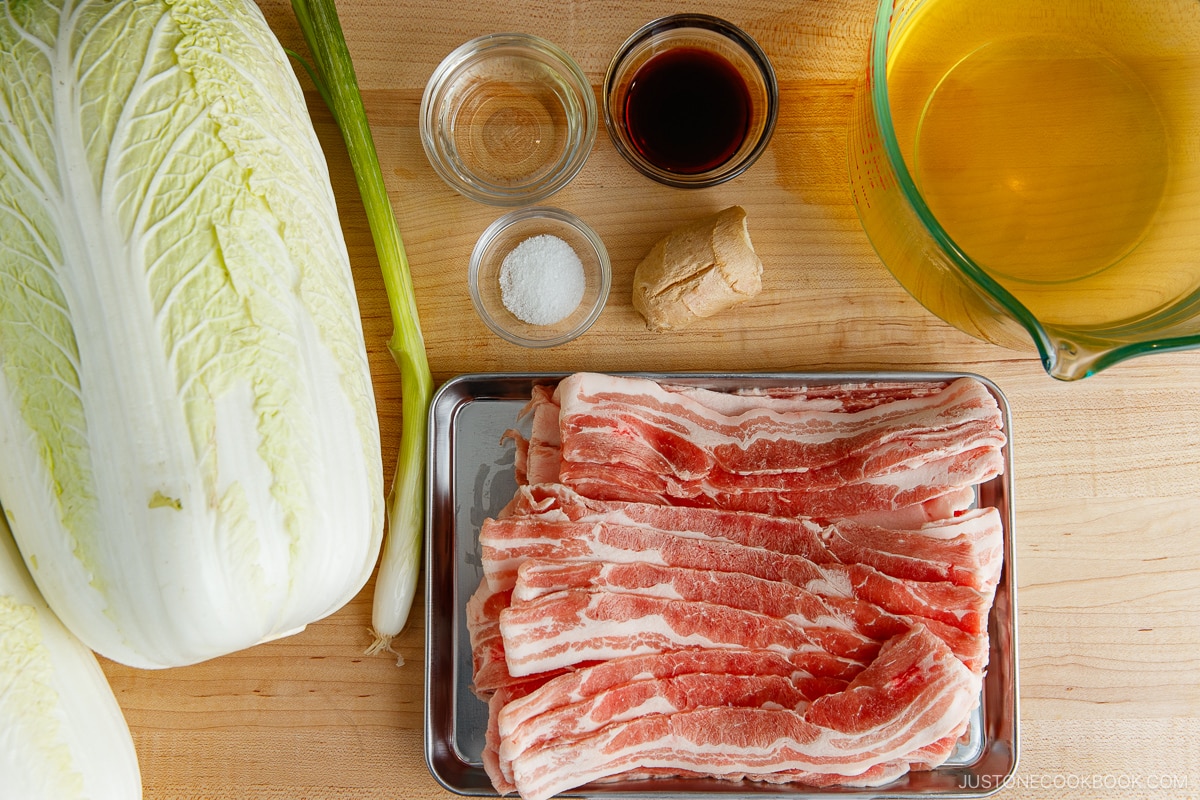
To Prepare the Ingredients
- To make the soup broth, combine 5 cups dashi (Japanese soup stock), 2 Tbsp sake, 1 Tbsp soy sauce, and ½ tsp Diamond Crystal kosher salt in a measuring cup or mixing bowl. Tip: Don’t reduce the salt since the napa cabbage will release liquid during cooking and dilute the soup.
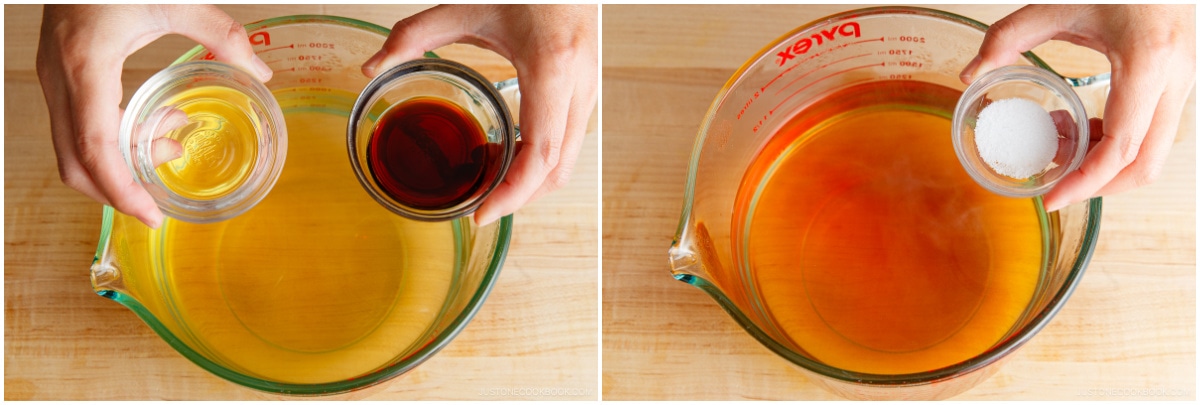
- Peel and thinly slice the ginger knob into 8–10 slices ginger and set it aside.
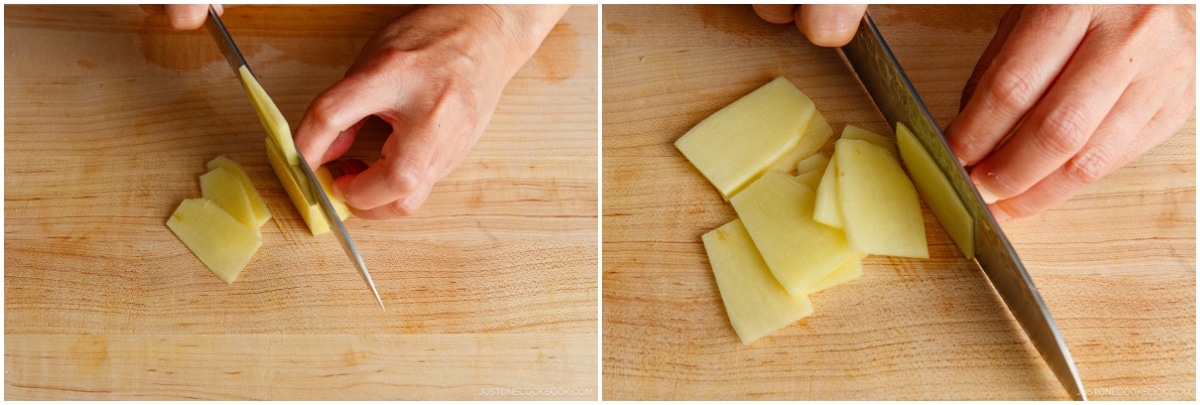
- Thinly cut 1 green onion/scallion. Put the green onion in a small serving bowl to add later to the dipping sauce.
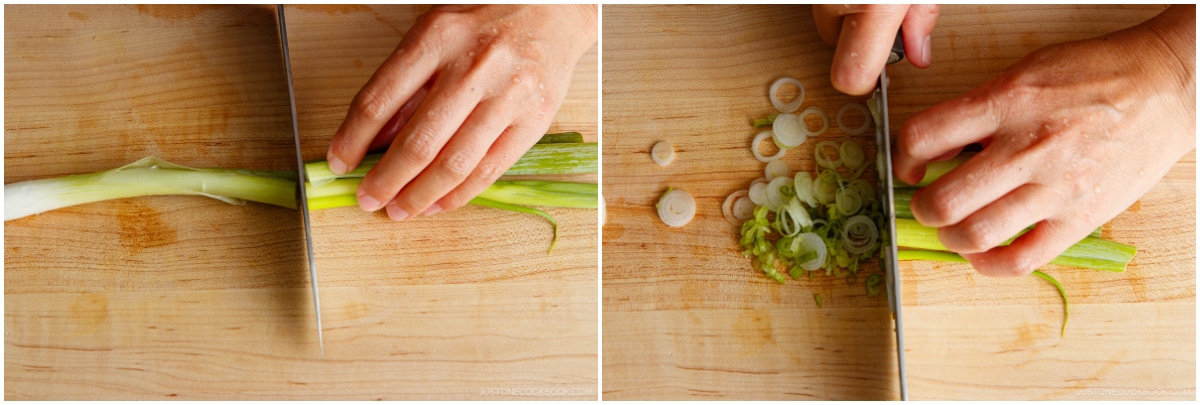
- Cut 1 head napa cabbage lengthwise into quarters. I like to cut just the white bottom half with a sharp knife, then pull apart the leafy top half with my hands. By tearing it naturally, you lose fewer leaves compared to slicing. DO NOT cut off the core from the wedges yet. They keep the leaves attached and make layering the pork belly much easier.
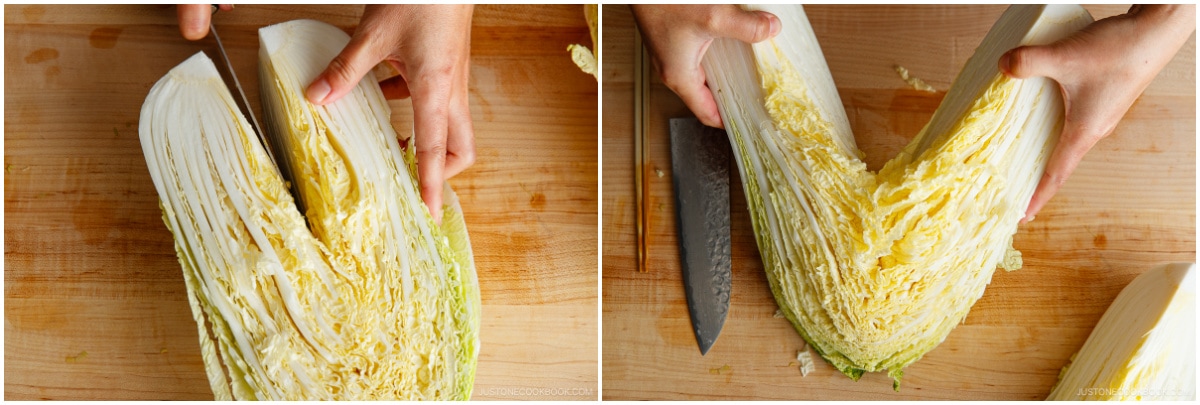
- Carefully wash the leaves without detaching them from the core. Drain well. Don’t throw away any leaves that naturally come off while rinsing. We’ll use them later on.
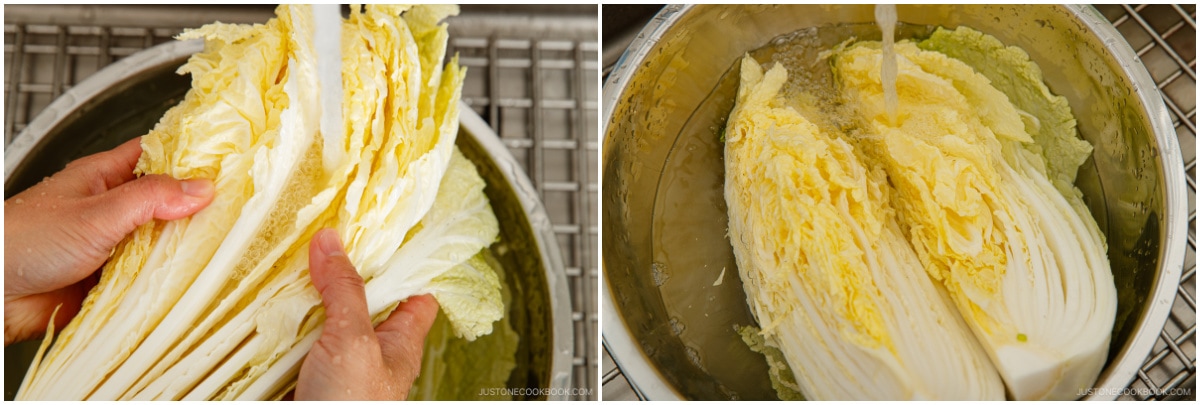
To Make the Layers
- Layer 1½ lb sliced pork belly into the napa cabbage wedges by placing one pork belly slice between each of the leaves. If the pork belly is longer than the cabbage wedge, trim the pork with kitchen shears and layer it in other parts of the wedge. If you have extra pork belly, put an additional slice in the outer layers that have wide leaves.
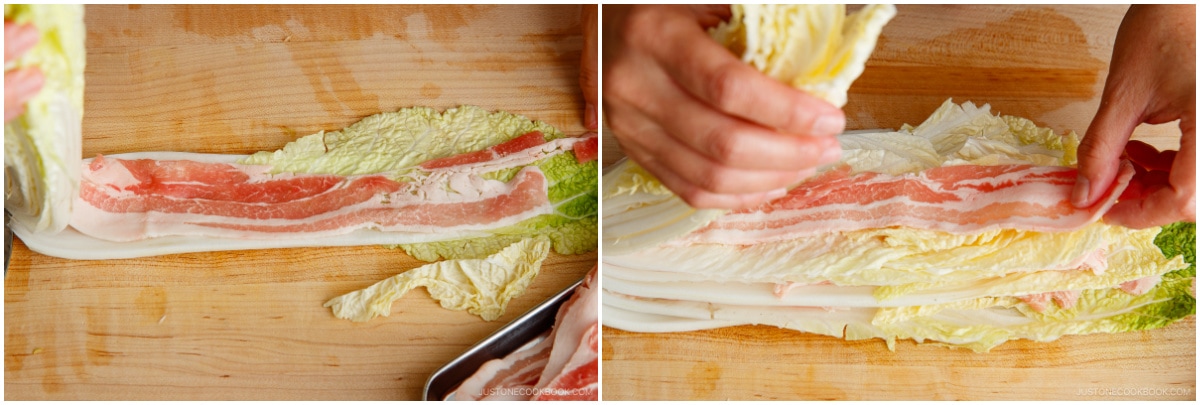
- Once you‘ve tucked in the pork belly slices, carefully cut off the hard cabbage cores without disturbing the layers. Cut each wedge into 4 pieces that are each about 2–2½ inches (5–6 cm) long. Keeping the layers of cabbage and pork neatly stacked as you slice.
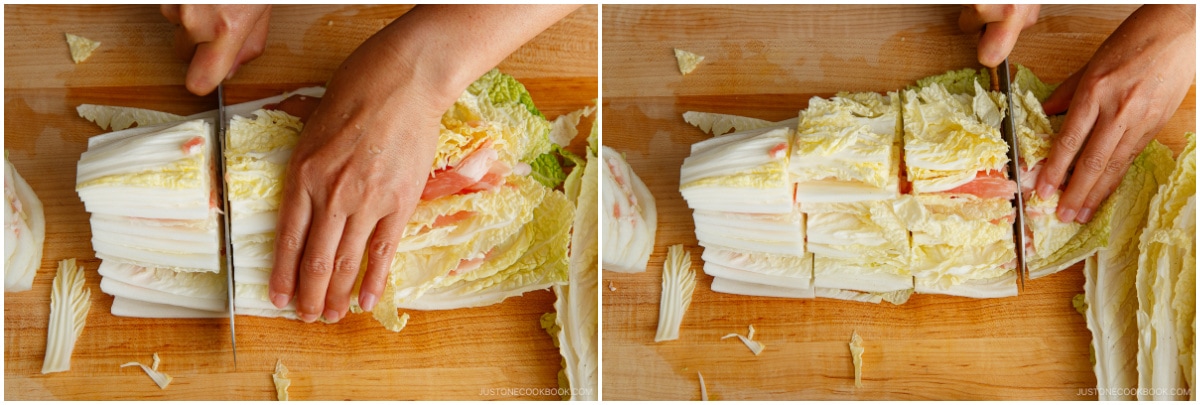
To Pack the Pot
- Prepare a donabe or regular 10-inch pot (I used a 4.5 QT Le Creuset pot; if you‘re doubling the recipe, use two 10-inch pots or one larger pot). Begin to pack the ingredients starting from the edge of the pot and working your way toward the center. Turn the stacks on their side so the pink and green layers are visible. Position the layers parallel to the pot‘s side so they eventually form concentric circles in the pot.
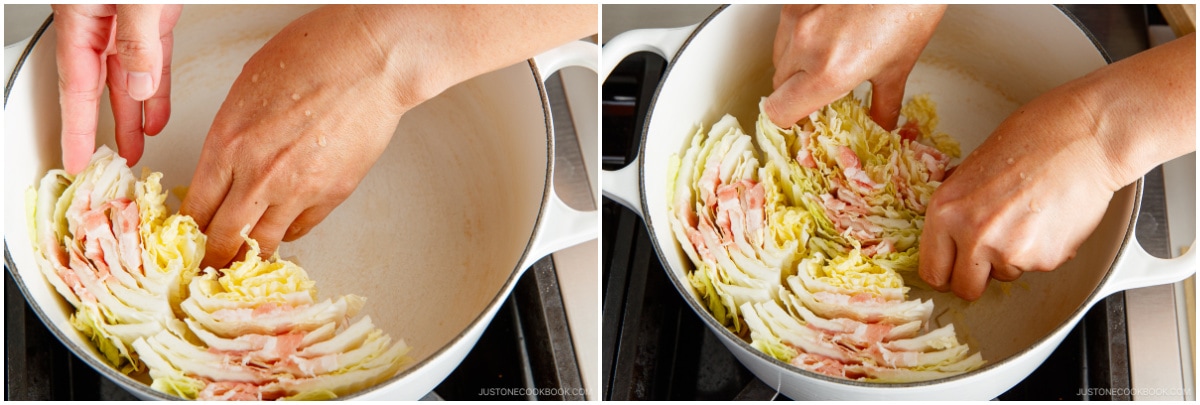
- I usually place the thicker cabbage leaves near the edge of the pot and the tender leaves in the center. Make sure to pack the pot tightly as the layers will become loose during cooking.
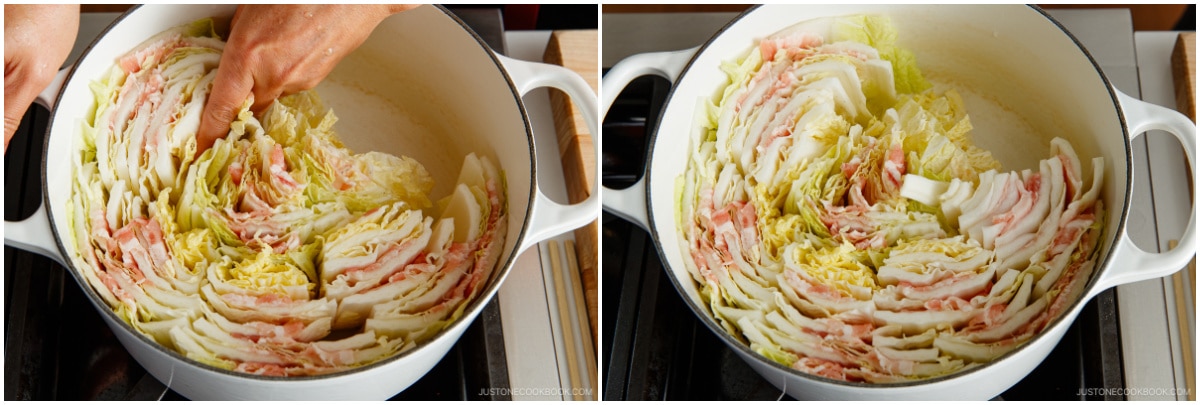
- If you don’t have enough layers to pack the pot tightly, consider using a smaller pot or place other ingredients in the center. Here, I stuffed the napa cabbage leaves that came off when I cut and rinsed the cabbage. You can also put enoki mushrooms or shimeji mushrooms in the center.
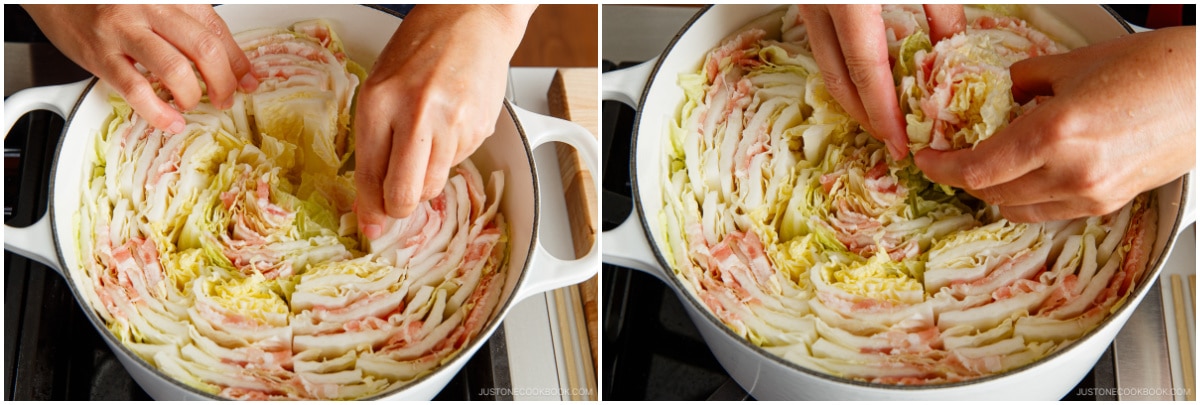
- If you have extra layers, hold them in a deep baking dish or a container with a tall rim. You can add them to the pot later after you‘ve remove most of the cooked layers.
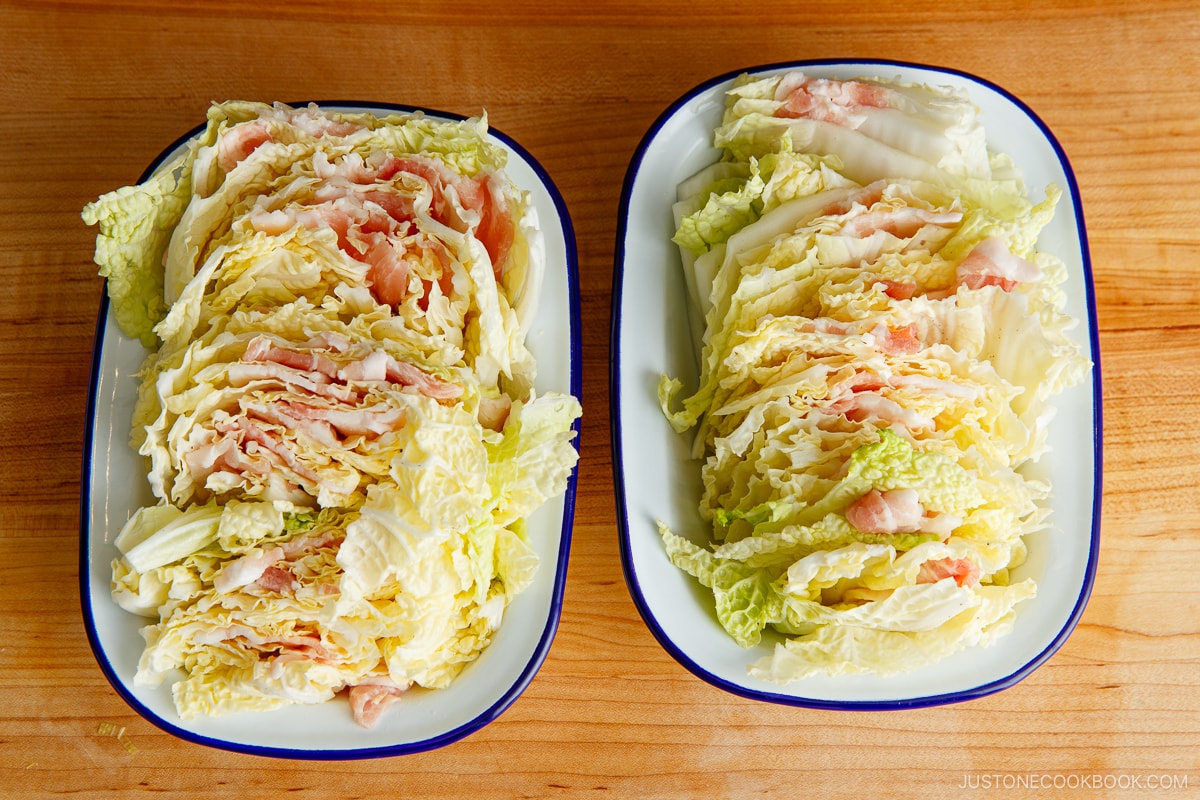
- Insert the thinly sliced ginger between the layers.
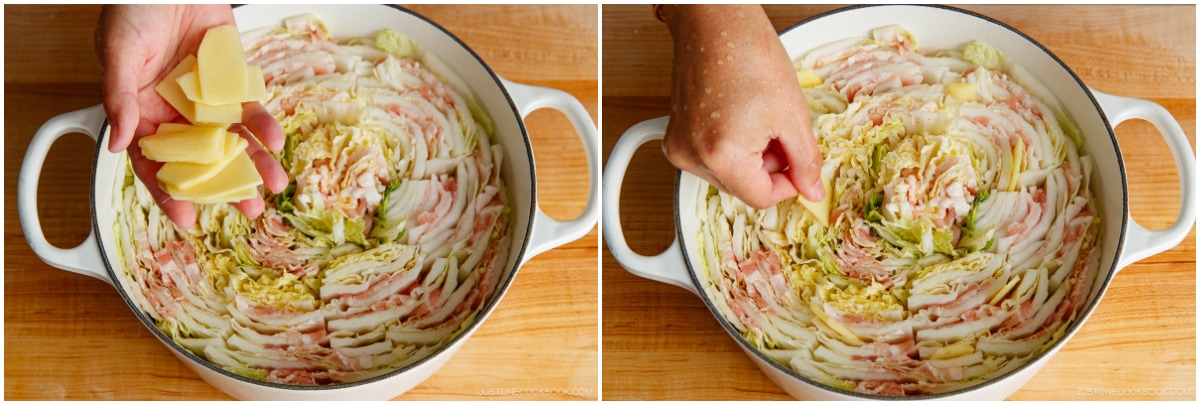
- Pour the soup broth into the pot with the cabbage and pork layers. If you are cooking at the table, bring the pot to the table. Otherwise, start cooking it on the stove (see below).
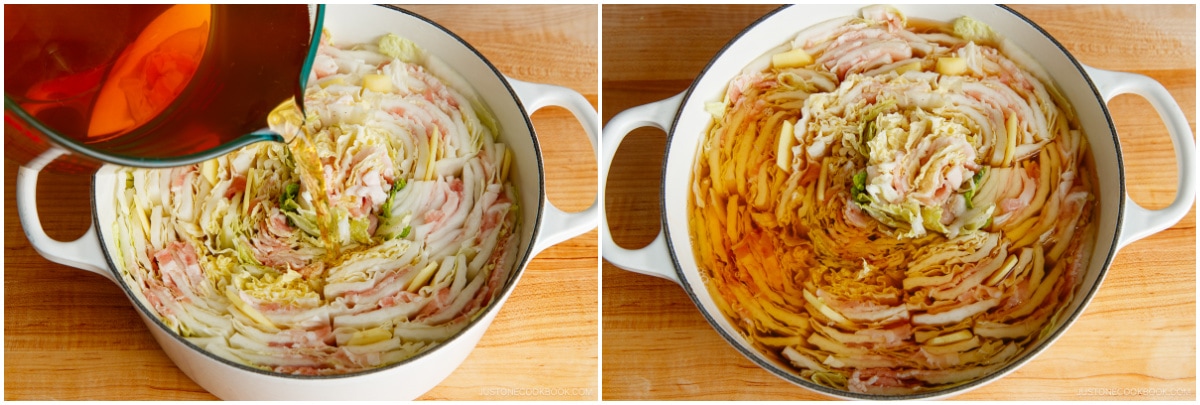
To Set up the Table
- At each place setting, prepare a medium bowl and a small dipping bowl for each person. To cook at the table, set it up a portable gas stove and place the pot on it.For the dipping sauce, add ponzu, the chopped green onion/scallion, and optional shichimi togarashi (Japanese seven spice) to the small bowls.
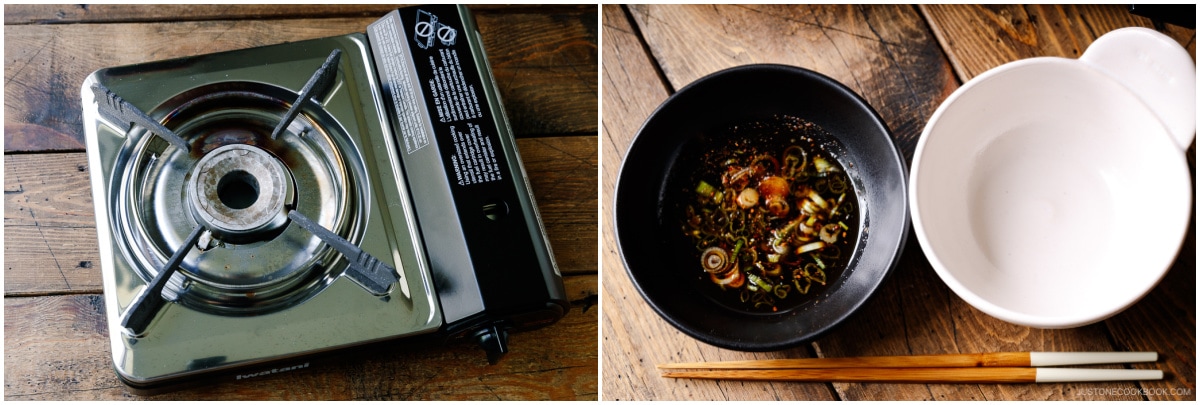
To Cook and Serve
- Start cooking, covered, on medium-high heat. Once boiling, skim off the scum and fat on the surface using a fine-mesh skimmer. Then, reduce the heat to medium low and cook covered until the napa cabbage is tender and the pork belly is cooked through, roughly 8–10 minutes. Serve it hot dipped in ponzu sauce and enjoy!
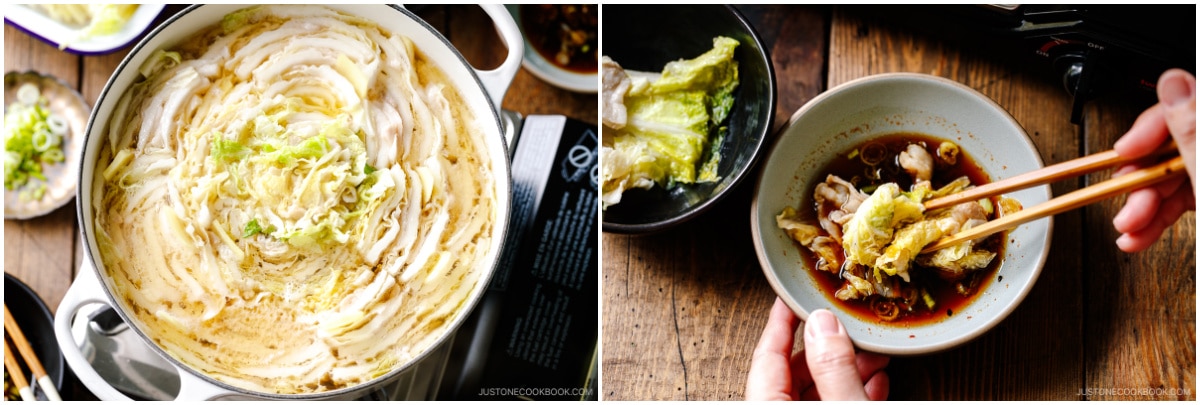
To Store
- You can keep the leftovers in an airtight container and store in the refrigerator for up to 3 days or in the freezer for a month.
Notes
Nutrition
Did you make this recipe?
Tag @justonecookbook on Instagram so we can see your delicious creation!
Editor’s Note: This post was originally published on January 6, 2016, and updated with a new video and new images on November 10, 2023. It was republished with updated content on March 30, 2025.




